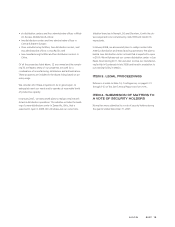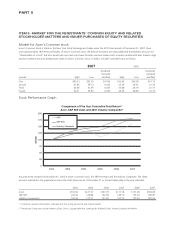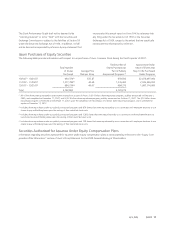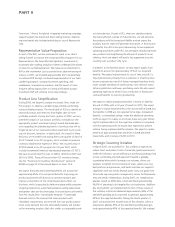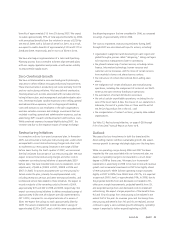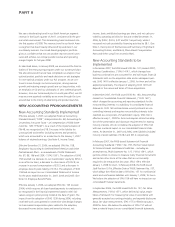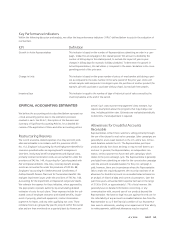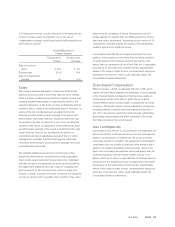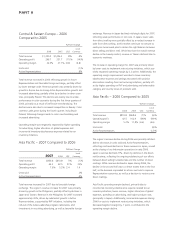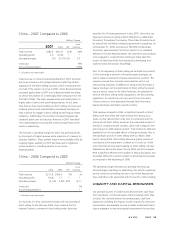Avon 2007 Annual Report Download - page 30
Download and view the complete annual report
Please find page 30 of the 2007 Avon annual report below. You can navigate through the pages in the report by either clicking on the pages listed below, or by using the keyword search tool below to find specific information within the annual report.PART II
Allowances for Sales Returns
We record a provision for estimated sales returns based on histor-
ical experience with product returns. Over the past three years,
sales returns have been in the range of $289 to $338, or approx-
imately 3.4% of total revenue. If the historical data we use to
calculate these estimates does not approximate future returns,
due to changes in marketing or promotional strategies, or for
other reasons, additional allowances may be required.
Provisions for Inventory Obsolescence
We record an allowance for estimated obsolescence equal to the
difference between the cost of inventory and the estimated
market value. In determining the allowance for estimated obso-
lescence, we classify inventory into various categories based
upon its stage in the product life cycle, future marketing sales
plans and the disposition process. We assign a degree of obso-
lescence risk to products based on this classification to determine
the level of obsolescence provision. If actual sales are less favor-
able than those projected by management, additional inventory
allowances may need to be recorded for such additional obso-
lescence. Annual obsolescence expense was $280.6, $179.7 and
$93.3 for the years ended December 31, 2007, 2006 and 2005,
respectively. As discussed in the Overview section, 2007 and
2006 include inventory obsolescence charges of $167.3 and
$72.6, respectively, related to our PLS program and 2006 also
includes $20.5 related to our decision to discontinue the sale of
heavily discounted excess products.
Pension, Postretirement and
Postemployment Benefit Expense
We maintain defined benefit pension plans, which cover sub-
stantially all employees in the U.S. and in certain international
locations. Additionally, we have unfunded supplemental pension
benefit plans for certain current and retired executives (see Note
10, Employee Benefit Plans).
Our calculations of pension, postretirement and postemployment
costs are dependent upon the use of assumptions, including
discount rates, expected return on plan assets, interest cost,
health care cost trend rates, benefits earned, mortality rates, the
number of associate retirements, the number of associates elect-
ing to take lump-sum payments and other factors. Actual results
that differ from assumptions are accumulated and amortized to
expense over future periods and, therefore, generally affect
recognized expense in future periods. At December 31, 2007,
we had pretax actuarial losses of $325.2 and $177.7 for the U.S.
and non-U.S. plans, respectively, that have not yet been charged
to expense. These actuarial losses have been charged to accumu-
lated other comprehensive loss within equity in accordance with
SFAS 158, which was adopted December 31, 2006. While we
believe that the assumptions used are reasonable, differences in
actual experience or changes in assumptions may materially
affect our pension, postretirement and postemployment obliga-
tions and future expense.
For 2007, the weighted average assumed rate of return on all
pension plan assets, including the U.S. and non-U.S. plans was
7.5%. In determining the long-term rates of return, we consider
the nature of the plans’ investments, an expectation for the
plans’ investment strategies, historical rates of return and current
economic forecasts. We evaluate the expected long-term rate of
return annually and adjust as necessary.
The majority of our pension plan assets relate to the U.S. pension
plan. The assumed rate of return for 2007 for the U.S. plan was
8.0%, which was based on an asset allocation of approximately
33% in corporate and government bonds and mortgage-backed
securities (which are expected to earn approximately 5% to 7%
in the long term) and 67% in equity securities (which are
expected to earn approximately 8% to 10% in the long term).
Historical rates of return on the assets of the U.S. plan for the
most recent 10-year and 20-year periods were 6.62% and
9.91%, respectively. In the U.S. plan, our asset allocation policy
has favored U.S. equity securities, which have returned 5.8%
and 11.97%, respectively, over the 10-year and 20-year periods.
The actual rate of return on plan assets in the U.S. was 9.3%
and 13.1% in 2007 and 2006, respectively.
The discount rate used for determining future pension obliga-
tions for each individual plan is based on a review of long-term
bonds that receive a high-quality rating from a recognized rating
agency. The discount rates for our more significant plans, includ-
ing our U.S. plan, were based on the internal rates of return for
a portfolio of high quality bonds with maturities that are con-
sistent with the projected future benefit payment obligations of
each plan. The weighted-average discount rate for U.S. and
non-U.S. plans determined on this basis was 5.88% at
December 31, 2007, and 5.43% at December 31, 2006.
Future effects of pension plans on our operating results will
depend on economic conditions, employee demographics, mortal-
ity rates, the number of associates electing to take lump-sum
payments, investment performance and funding decisions, among
other factors. However, given current assumptions (including
those noted above), 2008 pension expense related to the U.S.
plan is expected to decrease in the range of $2.0 to $4.0.



